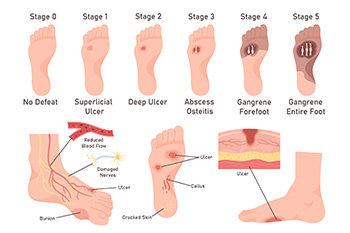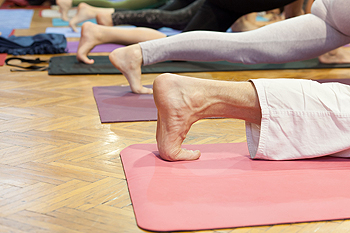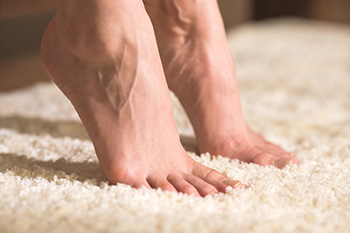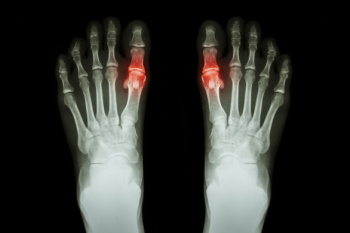Connect With Us
Blog
Items filtered by date: January 2025
Grades of Diabetic Foot Ulcers

Diabetic foot ulcers, or DFUs, are open sores that often develop in the ball of the foot, heel, or tips of the toes. Diabetic foot ulcers result from nerve damage and poor circulation caused by prolonged high blood sugar levels, which impair sensation and slow healing. Without proper care, DFUs can lead to serious infections, gangrene, or limb loss. The Wagner classification system is commonly used to assess the severity of DFUs. It includes six grades: Grade 0 indicates no open lesions but a high-risk foot. Grade 1 refers to superficial ulcers. Grade 2 involves deeper ulcers that extend to ligaments or muscles. Grade 3 signifies ulcers with bone involvement or abscess. Grade 4 describes localized gangrene of the forefoot. Grade 5 represents extensive gangrene of the entire foot. These stages help a podiatrist determine the best course of treatment, including wound care and infection management, to prevent further complications. If you have developed a foot ulcer related to diabetes, it is suggested that you make an appointment with a podiatrist for regular exams and necessary treatment.
Diabetic foot care is important in preventing foot ailments such as ulcers. If you are suffering from diabetes or have any other concerns about your feet, contact David Reynolds, DPM from First Podiatry. Our doctor can provide the care you need to keep you pain-free and on your feet.
Diabetic Foot Care
Diabetes affects millions of people every year. The condition can damage blood vessels in many parts of the body, especially the feet. Because of this, taking care of your feet is essential if you have diabetes, and having a podiatrist help monitor your foot health is highly recommended.
The Importance of Caring for Your Feet
- Routinely inspect your feet for bruises or sores.
- Wear socks that fit your feet comfortably.
- Wear comfortable shoes that provide adequate support.
Patients with diabetes should have their doctor monitor their blood levels, as blood sugar levels play such a huge role in diabetic care. Monitoring these levels on a regular basis is highly advised.
It is always best to inform your healthcare professional of any concerns you may have regarding your feet, especially for diabetic patients. Early treatment and routine foot examinations are keys to maintaining proper health, especially because severe complications can arise if proper treatment is not applied.
If you have any questions, please feel free to contact our office located in Evansville, IN . We offer the newest diagnostic and treatment technologies for all your foot care needs.
See Your Foot Specialist Regularly If You Work On Your Feet
Yoga Is Good for Feet

Yoga stretches can be incredibly beneficial for foot health by improving flexibility, strength, and circulation. Poses like downward dog, mountain pose, and toe stretch help to stretch the plantar fascia, Achilles tendon, and foot muscles. This can reduce the tension and prevent conditions like plantar fasciitis, Achilles tendonitis, and arch pain. Engaging in a regular yoga practice can also enhance balance and alignment, which helps address flat feet and overpronation. Gentle stretches improve joint mobility, reducing stiffness caused by arthritis or prolonged standing. Additionally, yoga’s focus on mindful movement encourages better weight distribution and posture, relieving stress on the feet and ankles. However, while yoga can alleviate discomfort and prevent minor issues, persistent pain or structural concerns require professional evaluation. If you are experiencing ongoing foot or ankle problems, consult a podiatrist for a proper diagnosis and personalized treatment plan.
Stretching the feet is a great way to prevent injuries. If you have any concerns with your feet consult with David Reynolds, DPM from First Podiatry. Our doctor will assess your condition and provide you with quality foot and ankle treatment.
Stretching the Feet
Being the backbone of the body, the feet carry your entire weight and can easily become overexerted, causing cramps and pain. As with any body part, stretching your feet can serve many benefits. From increasing flexibility to even providing some pain relief, be sure to give your feet a stretch from time to time. This is especially important for athletes or anyone performing aerobic exercises, but anyone experiencing foot pain or is on their feet constantly should also engage in this practice.
Great ways to stretch your feet:
- Crossing one leg over the others and carefully pull your toes back. Do 10-20 repetitions and repeat the process for each foot
- Face a wall with your arms out and hands flat against the wall. Step back with one foot and keep it flat on the floor while moving the other leg forward. Lean towards the wall until you feel a stretch. Hold for 30 seconds and perform 10 repetitions for each foot
- Be sure not to overextend or push your limbs too hard or you could risk pulling or straining your muscle
Individuals who tend to their feet by regular stretching every day should be able to minimize foot pain and prevent new problems from arising.
If you have any questions please contact our office located in Evansville, IN . We offer the newest diagnostic and treatment technologies for all your foot and ankle needs.
Giving Your Feet a Workout

Keeping your feet, toes, and ankles strong and flexible can help alleviate pain and reduce the risk of injuries. Simple foot exercises, like standing heel raises or toe spreading, improve strength and stability, while stretches such as the Achilles tendon stretch enhance flexibility. Balance exercises, like standing on one foot, also play a role in building ankle stability. Ankle rotations or writing the alphabet with your big toe can increase joint mobility and coordination. These activities are particularly helpful for addressing issues in the feet, toes, and ankles caused by strain or stiffness. If you experience difficulty performing these exercises or are unsure of where to begin, a podiatrist can assess your specific needs and offer guidance on suitable exercises. This foot doctor can also identify other issues that may require further treatment to prevent ongoing discomfort or injury. If you regularly experience aches and pains in your feet, it is suggested that you schedule an appointment with a podiatrist for an exam and treatment.
Exercising your feet regularly with the proper foot wear is a great way to prevent injuries and build strength. If you have any concerns about your feet, contact David Reynolds, DPM from First Podiatry. Our doctor can provide the care you need to keep you pain-free and on your feet.
Exercise for Your Feet
Exercise for your feet can help you gain strength, mobility and flexibility in your feet. They say that strengthening your feet can be just as rewarding as strengthening another part of the body. Your feet are very important, and we often forget about them in our daily tasks. But it is because of our feet that are we able to get going and do what we need to. For those of us fortunate enough to not have any foot problems, it is an important gesture to take care of them to ensure good health in the long run.
Some foot health exercises can include ankle pumps, tip-toeing, toe rises, lifting off the floor doing reps and sets, and flexing the toes. It is best to speak with Our doctor to determine an appropriate regimen for your needs. Everyone’s needs and bodies are different, and the activities required to maintain strength in the feet vary from individual to individual.
Once you get into a routine of doing regular exercise, you may notice a difference in your feet and how strong they may become.
If you have any questions, please feel free to contact our office located in Evansville, IN . We offer the newest diagnostic and treatment technologies for all your foot care needs.
Living With Gout

Gout is a form of arthritis that occurs when uric acid builds up in the blood, forming crystals that accumulate in the joints, causing severe pain and swelling. It commonly affects the big toe but can occur in other joints as well. Symptoms of gout include intense, sudden pain, redness, warmth, and swelling in the affected joint. Diagnosing gout typically involves a physical examination, blood tests to check uric acid levels, and sometimes joint fluid analysis to detect uric acid crystals. Living with gout requires managing symptoms and preventing flare-ups. This can be done through dietary changes, such as limiting foods high in purines and taking medications to lower uric acid levels. Regular exercise and maintaining a healthy weight can also help reduce the risk of future attacks. Gout attacks can be excruciating. If this has happened to you, it is strongly suggested that you are under the care of a podiatrist who can help you manage this painful condition.
Gout is a foot condition that requires certain treatment and care. If you are seeking treatment, contact David Reynolds, DPM from First Podiatry. Our doctor will treat your foot and ankle needs.
What Is Gout?
Gout is a type of arthritis caused by a buildup of uric acid in the bloodstream. It often develops in the foot, especially the big toe area, although it can manifest in other parts of the body as well. Gout can make walking and standing very painful and is especially common in diabetics and the obese.
People typically get gout because of a poor diet. Genetic predisposition is also a factor. The children of parents who have had gout frequently have a chance of developing it themselves.
Gout can easily be identified by redness and inflammation of the big toe and the surrounding areas of the foot. Other symptoms include extreme fatigue, joint pain, and running high fevers. Sometimes corticosteroid drugs can be prescribed to treat gout, but the best way to combat this disease is to get more exercise and eat a better diet.
If you have any questions, please feel free to contact our office located in Evansville, IN . We offer the newest diagnostic and treatment technologies for all your foot care needs.

